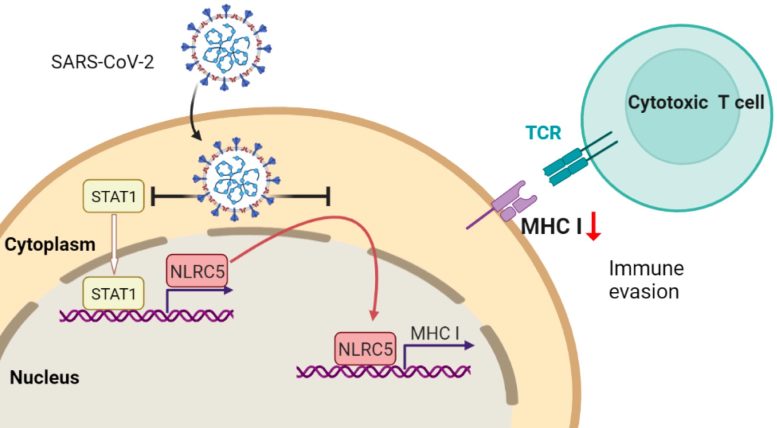The expression of the immune response gene ??NLRC5 (red purple) is suppressed in SARS-CoV-2 (green) infected cells. Credit: Koichi Kobayashi
A discovery by researchers at the Texas A&M College of Medicine could lead to new therapies to prevent the virus from proliferating in the human body.
The immune system is a complex network of cells and proteins that is designed to fight off infection and disease, especially those like the coronavirus, or
SARS-CoV-2 escapes from immune responses by cytotoxic T cells via impaired MHC-I expression which is caused by reducing both the amount and function of NLRC5. Credit: Koichi Kobayashi
“We found that the SARS-CoV-2 virus carries a suppressive gene that acts to inhibit a human gene in the immune system that is essential for destroying infected cells,” said Dr. Koichi Kobayashi, adjunct professor at the College of Medicine and lead author of the paper.
Naturally, the cells in a human’s immune system are able to control virus infection by destroying infected cells so that the virus cannot be replicated. The gene that is essential in executing this process, called NLRC5, regulates major histocompatibility complex (MHC) class I genes, which are genes that create a pathway that is vital in providing antiviral immunity. Kobayashi and his colleagues discovered this in 2012.
“During infection, the amount and activity of NLRC5 gene become augmented in order to boost our ability of eradication of viruses,” Kobayashi said. “We discovered that the reason why SARS-CoV-2 can replicate so easily is because the virus carries a suppressive gene, called ORF6, that acts to inhibit the function of NLRC5, thus inhibiting the MHC class I pathway as well.”

Dr. Koichi Kobayashi, adjunct professor at the College of Medicine and lead author of the paper. Credit: Texas A&M College of Medicine
Kobayashi, who holds a joint appointment as a professor at Hokkaido University in Japan, collaborated with Paul de Figueiredo, associate professor in the Department of Microbial Pathogenesis and Immunology at the College of Medicine, on this paper.
Kobayashi and his team’s discovery shed light on the mechanism to how SARS-CoV-2 can replicate in the human body and can potentially lead to the development of new therapeutics to prevent the coronavirus from escaping the immune system and replicating in the body.
Although the introduction of (function(d, s, id){
var js, fjs = d.getElementsByTagName(s)[0];
if (d.getElementById(id)) return;
js = d.createElement(s); js.id = id;
js.src = "https://connect.facebook.net/en_US/sdk.js#xfbml=1&version=v2.6";
fjs.parentNode.insertBefore(js, fjs);
}(document, 'script', 'facebook-jssdk'));
Read original article here
